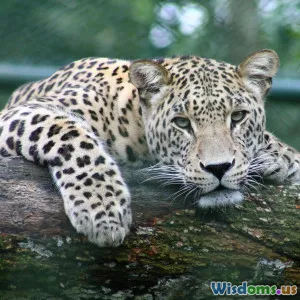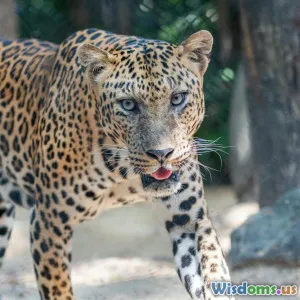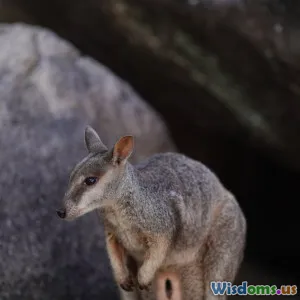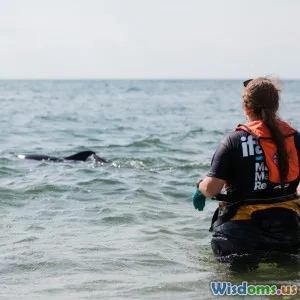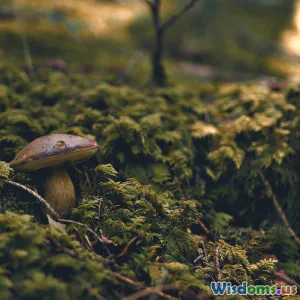
Beyond Pandas The Lesser Known Red List Mammals
14 min read Discover rare and overlooked endangered mammals on the IUCN Red List, and learn why their survival matters just as much as the panda’s. (0 Reviews)
Beyond Pandas: The Lesser Known Red List Mammals
Introduction
When we imagine endangered wildlife, images of majestic pandas, noble tigers, or hulking rhinos often fill our minds. But beneath the global spotlight, hundreds of fascinating mammal species fight quietly against extinction’s encroaching shadow. Who champions the fate of the Senegal bushbaby, the saola (“Asian unicorn”), or the elusive Hispaniolan solenodon? The International Union for Conservation of Nature (IUCN) Red List catalogs thousands of animal species at risk, many so under-the-radar that most people have never even heard their names.
Why do some animals gather worldwide attention while others fade further into oblivion? What are their stories, and why must we care? Wildlife conservation is not merely about saving charismatic megafauna. It's about protecting an intricate web of life, all vital cogs in the ecosystems we depend on. In this article, we journey beyond pandas to uncover the remarkable—and sometimes bizarre—Red List mammals fighting for survival in a world awash with change.
A World Beyond the Icons: The Scope of Mammal Endangerment
Millions know the striking black-and-white face of the giant panda. Thanks in part to its appeal, the panda was downlisted from “Endangered” to “Vulnerable” in 2016 after decades of focused conservation investment. However, according to the IUCN 2023 update, over 1,300 mammal species are considered threatened with extinction (Vulnerable, Endangered, or Critically Endangered). Among these:
- Roughly 25% of mammals assessed face threat of extinction.
- Especially at risk are enigmatic, overlooked animals with limited geographic ranges, specialized habitat needs, or those impacted by invasive species and human expansion.
Beneath the icons lies a silent majority—a world replete with mammals whose names may be unfamiliar, yet whose fates hold equal weight in the balance of biodiversity.
A Gallery of the Overlooked: Meet the Lesser-Known Red List Mammals
Let’s lift the veil on some of these unsung species: their unique stories, roles in nature, and the uphill battles they face.
1. Saola (Pseudoryx nghetinhensis): The Legendary "Asian Unicorn"
Red List Status: Critically Endangered
Estimated Population: Possibly fewer than 100 individuals
Region: Annamite Range, Vietnam & Laos
“The Saola’s rarity makes the panda seem common.” — William Robichaud, Saola Working Group
Discovered by science only in 1992, this antelope-like creature defied centuries of naturalists and locals alike. Nicknamed the “Asian unicorn” due to its elusiveness and twin parallel horns, saolas are one of the planet's rarest large mammals. Poaching and habitat loss are their main threats; snare traps set for other animals often inadvertently doom saolas. Despite intensive efforts, few have ever been observed in the wild.
2. Hispaniolan Solenodon (Solenodon paradoxus): The Venomous Fossil
Red List Status: Endangered
Region: Hispaniola (Dominican Republic & Haiti)
Looking something like a shrew from the age of dinosaurs, the solenodon is a relic of an ancient lineage dating back 76 million years. This small, nocturnal mammal has venomous saliva—a rare trait in mammals—and a flexible, mobile snout used for rooting out insects. Surviving deforestation, habitat fragmentation, and introduced predators like dogs and cats, the solenodon is one of the Caribbean's last unique mammals.
3. Sunda Pangolin (Manis javanica): The World’s Most Trafficked Mammal
Red List Status: Critically Endangered
Range: Southeast Asia
Resembling a walking pinecone, pangolins are covered in protective keratin scales. Unfortunately, these scales made them the most-trafficked mammal on Earth. They’re killed for their meat and traditional medicine markets. Sunda pangolins are especially at risk due to heavy illegal trade counteracting any protections—or reproductive rates.
4. Senegal Bushbaby (Galago senegalensis): Africa’s Tiny Nighttime Acrobat
Red List Status: Least Concern—but many relatives, such as the Rondo dwarf galago, are Critically Endangered.
While Senegal bushbabies themselves aren’t so threatened, several lesser-known relatives face near-imminent extinction. Bushbabies are primates with enormous eyes (for night vision) and jump with incredible agility. Habitat loss and hunting, as well as their reliance on forest corridors, drive their more precarious kin toward disappearance.
5. Northern Hairy-Nosed Wombat (Lasiorhinus krefftii): Australia’s Forgotten Giant
Red List Status: Critically Endangered
Estimated Population: Under 300 (as of 2023)
Australia’s other famous marsupials get superstar billing, but the northern hairy-nosed wombat clings to life in a single, intensively managed reserve. The species was down to just 35 individuals in the 1980s, but conservation efforts steered that number up. Feral dog attacks, disease, fire, and limited genetic diversity still imperil their future.
6. Pygmy Three-Toed Sloth (Bradypus pygmaeus): The Mangrove Recluse
Red List Status: Critically Endangered
Range: Isla Escudo de Veraguas, Panama
This tiny sloth inhabits a single island, rarely descending from its mangrove canopy home. Fewer than 100 may remain, isolated by rising sea levels, habitat destruction, and small population size—making disease or catastrophe a possible population wipeout event.
7. Giant Sengi (Rhynchocyon spp.): Africa’s Secret Sprinters
Red List Status: Most giant sengi species are Endangered or Vulnerable
Range: Eastern Africa
Sengis, or “elephant shrews,” are not true shrews or elephants. These small mammals zip through forests and savannahs, using their long noses to sniff out insects. Habitat alteration, particularly forest fragmentation, threatens these ecologically intriguing creatures.
Why Do Lesser-Known Mammals Matter?
Guardians of Ecological Balance
Ecosystems are complex, interlocking assemblages—disturbing one cog can unravel the whole. Every mammal, from apex carnivore to obscure burrowing insectivore, plays its role:
- Seed Dispersal: Many forest mammals, such as the woolly spider monkey (Critically Endangered), are main seed dispersers for vital tree species. Without them, forest regeneration falters.
- Pest Control: Small carnivores and insectivores, like bushbabies and solenodons, keep insect populations in check, preventing outbreaks that could damage crops and forests.
- Ecosystem Engineering: Some, like the hairy-nosed wombat or the beavers, shape their entire environments, benefiting other species.
Losing niche mammals disrupts food webs, sometimes in cascading ways challenging to predict or repair.
Genetic Diversity: Nature’s Resilience
Each unique lineage is a library of genetic solutions. The solenodon, for example, represents tens of millions of years of evolutionary history unattested anywhere else on Earth. Such diversity provides adaptability to changing circumstances (including climate). The disappearance of specialized lineages can undermine this resilience.
Cultural & Scientific Value
Species like the saola inspire profound myth, reverence, or curiosity among local cultures and scientists alike. Each mammal lost curtails future opportunities: medicines may be developed from pangolin scales; insights into social behavior may arise from obscure, social rodents; foundational ecological questions may hinge on their roles.
“The extinction of a species is not merely a moral failure—it is a loss of possibility.” — Dr. Jane Goodall
The Shadows Overlooked: Why Are They Forgotten?
No Charisma, No Attention?
In conservation, public attention is often currency. Charismatic megafauna (large, appealing animals) naturally draw headlines and donor dollars. Animals with:
- Small sizes
- Nocturnal or reclusive tendencies
- Odd or “unattractive” appearances
- Limited spots in pop culture
…are rarely conservation mascots. Less funding translates to fewer programs, weaker enforcement, and insidious sliding toward extinction.
Neglect, Data Deficiency, and Misplaced Priorities
A shocking number of mammals are “Data Deficient,” meaning their population status is simply unknown. Without local research or monitoring, rapid declines can go undetected until too late. This is especially true on remote islands or in politically troubled regions, where research is limited.
Fragmented Landscapes, Fragmented Populations
As forests are felled and habitats carved up for agriculture or development, small mammal populations become isolated and vulnerable. Making matters worse, these animals often need specialized or contiguous habitats, so fragmentation spells doom.
Conservation in Unseen Corners: Success Stories and Hope
It’s not all doom and gloom. Where targeted attention and local partnerships combine, even the most precarious species can bounce back.
Wombat Rescue: From Brink to Breathing Room
The northern hairy-nosed wombat was perilously close to extinction. Interventions included predator-proof fencing; translocating individuals to a second reserve; and supplementing their food stocks. Result: the population nearly TEN-FOLDED in several decades, proving even ultra-rare creatures can rebound with proper care.
Pangolins: Turning the Tide Against Trafficking?
From 2017 onwards, all eight pangolin species received top-tier international protection under CITES. Some countries began scaling up seizures and burning confiscated wildlife products. Awareness efforts (including “World Pangolin Day” in February) have lifted the pangolin’s profile from anonymity—spurring public support and fresh funding.
Rediscovering the “Unicorn”
Conservationists deploying camera traps in Saola territory recently photographed footprints and possible body prints, fanning hope that this cryptic animal still persists. Cross-border cooperation between Laos and Vietnam, snare removal teams, and local rangers provide a fighting chance.
How Can You Help?
1. Learn and Advocate
Familiarity breeds care. Learn the names and stories of less-famous threatened mammals. Share their images and stories on social media, emphasizing the value of all biodiversity.
2. Choose Conservation Organizations with Broad Focus
Support NGOs that direct attention and resources to "forgotten" species (e.g., Durrell Wildlife Conservation Trust, EDGE of Existence). Monitor celebrated programs for evidence of including marginalized mammals in their efforts.
3. Petition for Research and Legal Protection
Contact policymakers to prioritize research funding for Data Deficient species and effective enforcement against illegal trade.
4. Responsible Tourism and Consumption
If traveling in regions of concern, avoid any attractions exploiting wildlife unethically. Never purchase products derived from threatened mammals (e.g., souvenirs or traditional remedies).
5. Join Citizen Science Initiatives
Global projects, from camera trap analysis to reporting wildlife sightings, crowdsource data for better monitoring. Your photo could confirm a surviving red list mammal!
Conclusion: Each Life a Story Worth Saving
The charismatic faces of the conservation movement rally action. But the fate of the world’s biodiversity depends on celebrating and protecting the full spectrum of mammalian life—from the unicorns we never see, to the burrowing architects disrupting the soil beneath our feet. By amplifying their stories and supporting holistic action, we step closer to a world where future generations know not only the panda, but the entire, marvelous cast of Earth's threatened mammals. Let knowledge spark concern, and let concern inspire change—before more unique species slip forever into silence.
Additional Resources
- IUCN Red List of Threatened Species
- EDGE of Existence Initiative
- Durrell Wildlife Conservation Trust
- Saola Foundation
- World Pangolin Day
“You cannot love what you do not know. By giving a name and a face to lost species, we are called to care—and to act.”—Gerald Durrell
Rate the Post
User Reviews
Popular Posts










